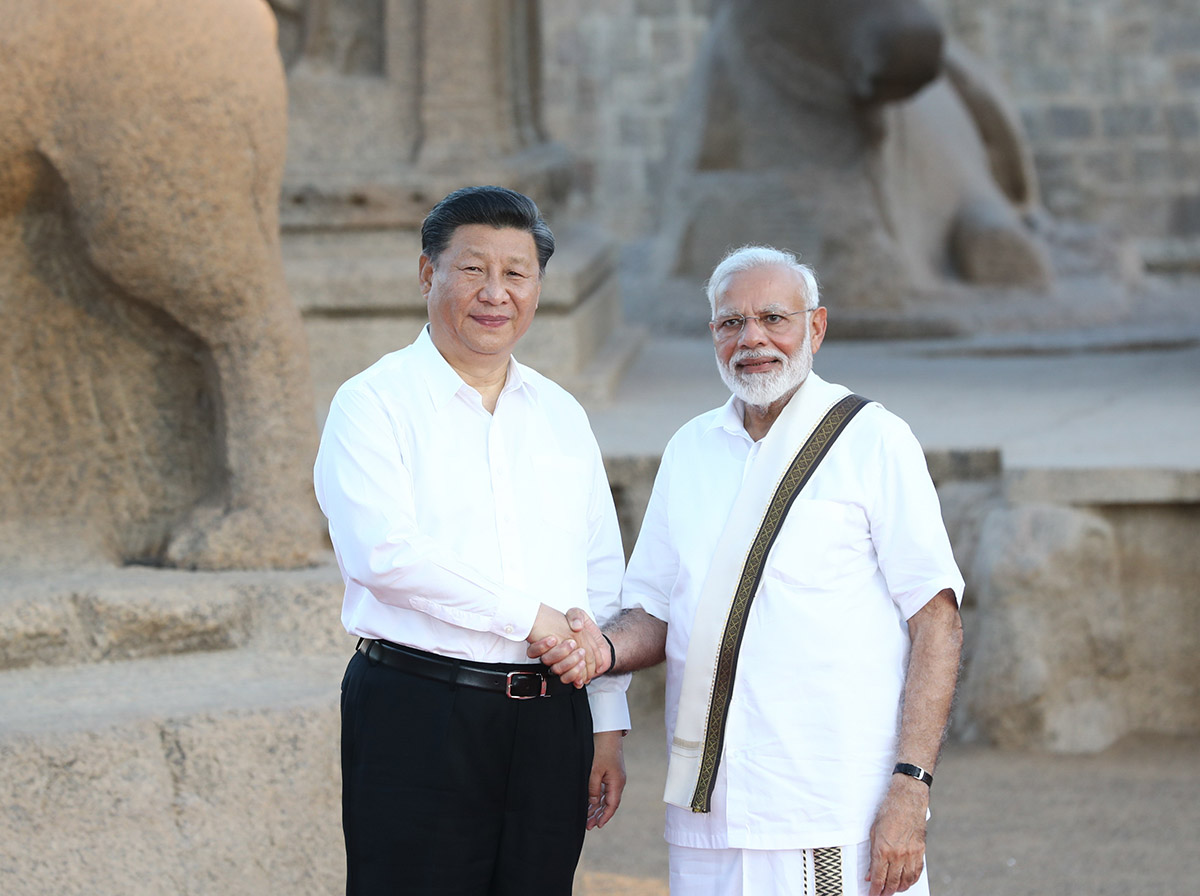Spirited Vision: Booming China-India Relations

Chinese President Xi Jinping visited India from October 11 to 12, 2019 as had long been planned. During his first informal meeting with Indian Prime Minister Narendra Modi in Wuhan in April 2018, a mechanism for annual informal meeting between the two leaders was quietly arranged. As early as June 2018 during the Qingdao summit of the Shanghai Cooperation Organization (SCO), India had already revealed plans for Xi’s visit to India.
The Wuhan summit was considered a “major milestone” in the development of China-India relations. The “Wuhan Spirit” forged at the informal meeting will guide the development of bilateral ties for some time. In 2017, the Indian prime minister first proposed Chinese and Indian leaders meeting informally. The two sides didn’t realize the great necessity and importance of such high-level summits until the abrupt breakout of the Dong Lang (Doklam) standoff.
The informal Xi-Modi meeting in Wuhan in April 2018 marked a “reboot” of China-India ties after the 2017 border standoff in the Dong Lang area. From that point on, a series of bilateral communication mechanisms were arranged and both sides began to monitor the other’s concern on sensitive core issues. For instance, although India is participating in the United States’ Indo-Pacific Strategy, Prime Minister Modi particularly stressed India’s strategic independence in his speech at the Shangri-La Dialogue in June 2018, declaring that India would adhere to a policy of independent diplomacy and does not see the Indo-Pacific Region as a “club of limited members”—indicating that the country’s strategy in the region involves more than just the United States, Japan, India and Australia.
New breakthroughs have been made on major bilateral issues between China and India. For example, the two countries resumed high-level military communication and urged border troops to take measures to stabilize the situation in border areas. The Meeting of the Special Representatives of China and India on the Boundary Question aimed to reap an “early harvest.” Moreover, establishment of the China-India high-level mechanism on cultural and people-to-people exchange and the launch of the “China-India plus” cooperation mechanism both injected new momentum and vitality into the development of bilateral ties.
Harnessing the “Wuhan Spirit,” the second Xi-Modi informal meeting in Chennai in October 2019 deepened China-India ties and engineered the “Chennai Vision.” “The Wuhan summit instilled a new momentum and trust in our relations and today’s ‘Chennai Vision’ is the start of a new era in India-China relations” Prime Minister Modi opined. During the Chennai summit, progress was made on multiple fronts in terms of building cooperation mechanisms and promoting cultural exchange between the two countries.
First, the two countries established a High-Level Economic and Trade Dialogue mechanism to strengthen alignment of their respective development strategies. The mechanism will help increase Chinese investment in India and design specific measures to reduce the bilateral trade imbalance. The two sides also agreed to explore the possibility of building a Manufacturing Partnership, which would clearly bolster the Modi government’s “Make in India” initiative.
Second, the Chennai summit lifted cultural and people-to-people exchange between the two countries to a new level. India chose to host the informal summit in Chennai so the two leaders could visit temples in Mamallapuram to promote mutual learning and communication between civilizations. Historically, Chennai and the state of Tamil Nadu maintained tight maritime trade connections with China. Even today, the city of Quanzhou in the southeastern Chinese province of Fujian has preserved considerable historical relics left by Tamil people who lived there as well as some Hindu relics. Exploring long-standing civilizational connections between the two countries and then engaging in communication on broad fronts will inject stronger spiritual momentum into the development of bilateral relations.
Inspired by their civilizational connections, the two sides decided to establish “sister- province/state relations” between Fujian and Tamil Nadu and “sister-city relations” between Quanzhou and Chennai. The year 2020 marks the 70th anniversary of the establishment of China-India diplomatic ties and has been designated as the “Year of India-China Cultural and People to People Exchange,” for which the two countries will organize a series of celebration activities.
Third, the two sides reached important consensus on strengthening coordination and cooperation in international and regional affairs. Since the Wuhan summit, both the international and regional situations have seen profound changes. Seeing the risk of the international order being sabotaged, India hopes to work together with China to promote an open, inclusive global trade arrangement. India’s economic development also requires an open, inclusive, prosperous and stable external environment. In this context, both China and India aspire to maintain regional prosperity and stability as they lay an early foundation for the establishment of the Regional Comprehensive Economic Partnership (RCEP).
During the summit, the two sides also discussed the possibility of gradually expanding “China-India plus” cooperation throughout South Asia, Southeast Asia and Africa to further facilitate regional connectivity. Such a move would mark a major boost to the “China-India plus” cooperation mechanism. The two countries will also explore new measures to consolidate mutual trust for negotiations on the boundary question. The “Wuhan Spirit” and the “Chennai Vision” are expected to play greater role in guiding future work on improving bilateral relations.
The author is a research fellow at the Institute of International Studies at Fudan University.